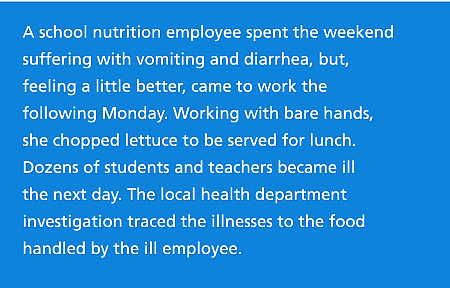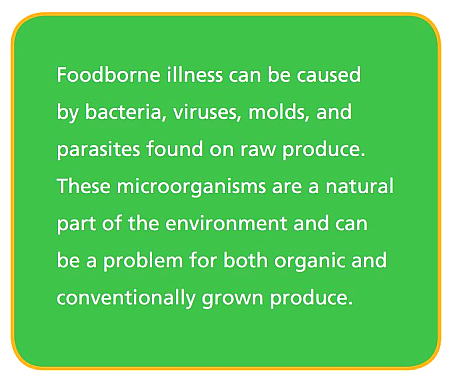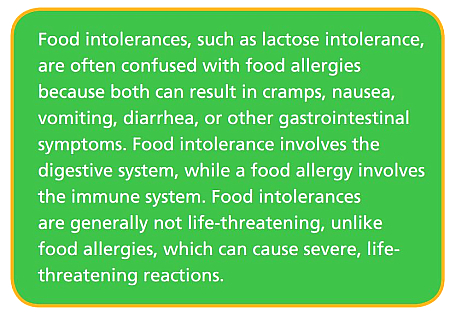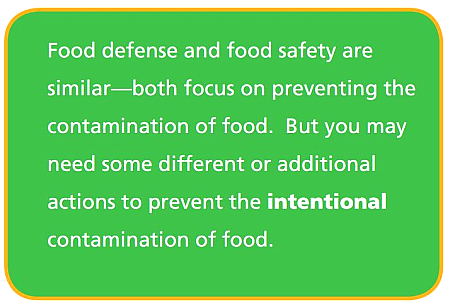
Now that you have completed the Action Guide checklist, you know which areas of food safety need your attention. You can turn to the Action Sheets in Part 2 for guidance in addressing these areas. Each Action Sheet addresses a specific area of food safety by providing you with background information, action steps that will help you build your framework, and resources for the in-depth information you will need to develop or strengthen that area.
The first Action Sheet focuses on information that will help you understand the food safety requirements of the National School Lunch Act. Understanding these requirements will give you a firm foundation for building food-safe schools. The remaining Action Sheets include information you will need to improve on your foundation and move to the next level of food safety.
Action Sheets
- The National School Lunch Act: Food Safety Requirements

The Richard B. Russell National School Lunch Act is a federal law that provides assistance to states in establishing, maintaining, operating, and expanding child nutrition programs offered through schools. It requires these programs to meet minimum food safety requirements. Child nutrition programs include the:
- National School Lunch Program
- School Breakfast Program
- Fresh Fruit and Vegetable Program
- National School Lunch Program Afterschool Snack Program
- Special Milk Program operated in schools
- Summer Food Service Program operated in schools
- Child and Adult Care Food Program operated in schools
The National School Lunch Act was most recently amended in 2010. It includes the food safety requirements established in the Healthy, Hunger-Free Kids Act of 2010 and the Child Nutrition and WIC Reauthorization Act of 2004.
Currently, the National School Lunch Act requires:
- School food authorities (SFAs) to implement a school food safety program that is based on HACCP principles. The food safety program must apply to every location where food is stored, prepared, or served for child nutrition programs offered through schools.
- Each school participating in the National School Lunch or School Breakfast Programs to:
- Obtain at least two food safety inspections each school year, conducted by a state or local governmental agency responsible for food safety inspections;
- Post, in a publicly visible location, a report on the most recent food safety inspection; and
- Provide a copy of the food safety inspection report to the public upon request.
Food-Safe Schools Action Steps and Resources
- Implement a school food safety program based on HACCP principles throughout your district.
- Apply your school food safety plan to every location where food is stored, prepared, or served for child nutrition programs.
- The USDA FNS created Guidance for School Food Authorities: Developing a School Food Safety Program Based on the Process Approach to HACCP to assist SFAs in developing a school food safety program based on the process approach to HACCP. You may have used this guidance to develop your existing food safety program or to modify your existing plan, if necessary.
- A frequently-asked-questions (FAQ) document was developed by the USDA FNS to guide you through the food safety requirements of the Healthy, Hunger-Free Kids Act of 2010.
- Work with your school district’s state or local agency responsible for conducting food safety inspections to ensure that each school in your district obtains the two required food safety inspections each school year.
- Verify that each school in your district posts its most recent food safety inspection report in a publicly visible location and provides copies of reports to the public upon request.
- A School Food Safety Program Based on Hazard Analysis and Critical Control Points (HACCP) Principles

Serving safe food is a critical responsibility for you and your school nutrition team and is also a recommendation of the Dietary Guidelines for Americans. Through a school food safety program, you can control the risks associated with storing, preparing, and serving food. The program should include a written plan based on HACCP principles and documented Standard operating procedures (SOPs). HACCP is a systematic approach to identifying, evaluating, and controlling food safety risks. USDA offers the process approach to HACCP principles as a foundation for your school food safety program.
SOPs are very important to an effective food safety program. They serve as a basic food safety platform, and they control for nonspecific risks that may not be addressed in the HACCP-based plan. For example, surfaces of equipment and utensils that are soiled and have not been sanitized should not come into contact with raw or cooked (ready-to-eat) food. Procedures to prevent this should be covered by an SOP.
Active managerial control (AMC) is another important concept that is critical to the success of a food safety program based on HACCP principles. AMC means that you and your school nutrition managers take a preventive, rather than reactive, approach to food safety by understanding and consistently applying the school food safety plan to prevent, eliminate, or reduce the occurrence of risks that may result in foodborne illness.
Food-Safe Schools Action Steps and Resources
- Develop and implement a written food safety plan based on the process approach to HACCP for every location where food is stored, prepared, or served.
- The USDA FNS Guidance for School Food Authorities: Developing a School Food Safety Program Based on the Process Approach to HACCP identifies the need to develop food safety SOPs and the minimum elements you must include in using HACCP principles and a process approach to HACCP.
- The ICN has resources for developing a School Food Safety Program, which include the required elements and provide practical planning approaches.
- Develop SOPs for each school within your district.
- The ICN also offers a workshop for school nutrition professionals called Writing, Updating, and Revising a HACCP-Based Food Safety Plan for Schools.
- Use HACCP-based recipes in your school nutrition operations.
- USDA's Team Nutrition offers Recipes for school nutrition operations.
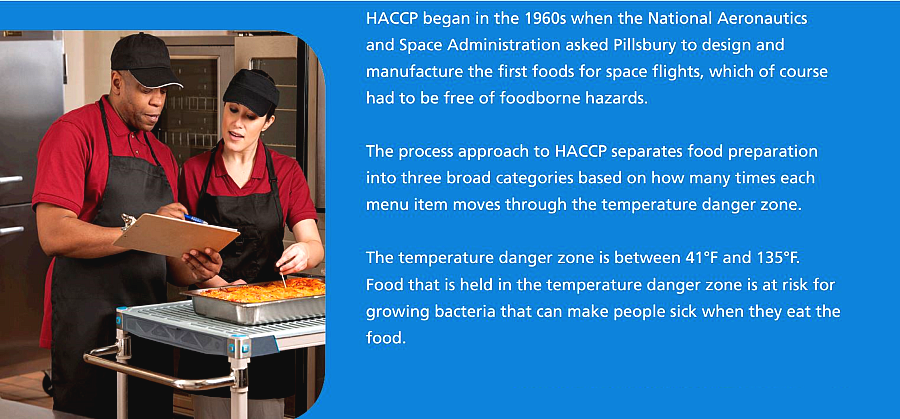
- Develop and implement a written food safety plan based on the process approach to HACCP for every location where food is stored, prepared, or served.
- Training and Education

You may be responsible for food prepared and served in many schools by many people. As a school nutrition director, you can do your part by ensuring that everyone with nutrition responsibilities is knowledgeable in food safety and safe food-handling practices.
Some of the most important responsibilities are to know and implement the state and local public health regulations, maintain up-to-date knowledge about food safety, and teach school nutrition employees about good food safety practices. Employees need training on basic food safety principles and on their role in applying these principles. They also need ongoing education to practice behaviors, reinforce concepts, and learn about new developments.
In addition, it is important that school nutrition directors and managers educate and train others in the school about food safety. For example, teachers may assist with serving breakfast to students in their classrooms; school bus drivers may oversee breakfast service on the bus; or students may help serve fruit and vegetable snacks in the school.
Food-Safe Schools Action Steps and Resources
- Consider earning a certification as a food protection manager. This training already may be required in your state or local food safety regulations.
- The American National Standards Institute (ANSI) lists accredited programs, as defined by the FDA Food Code, that offer a food protection manager certification program.
- Develop and implement a food safety training program for school nutrition managers and employees. Consider encouraging each manager to earn a certification as a food protection manager or a certificate in food safety and sanitation.
- Food Safety in Schools is a training program offered through the ICN that provides school nutrition personnel at all levels with information for managing a safe and sanitary nutrition operation.
- Continuing education should be offered to employees at least once each school year.
- The ICN offers a variety of training resources for child nutrition professionals.
- Consider earning a certification as a food protection manager. This training already may be required in your state or local food safety regulations.
- Employee Health and Personal Hygiene

Foodborne illness (also known as food poisoning or foodborne disease) is any illness that results from eating contaminated food. The CDC estimates that each year roughly 1 in 6 Americans (or 48 million people) gets sick from eating contaminated food.
Bacteria and viruses are the most common causes of foodborne illness. School nutrition employees can transfer bacteria and viruses from their hands to the food that they prepare. To prevent this, school nutrition employees should not work when they are sick, always wash their hands before preparing food, and use gloves or utensils when handling ready-to-eat food. It is your responsibility to educate and train school nutrition employees in these practices and to take action to prevent employees from contaminating food.
Food-Safe Schools Action Steps and Resources
- Develop and implement a written policy or SOP that:
- Requires employees to report certain diagnosed illnesses and symptoms of illness, and
- Restricts or excludes ill employees from preparing or serving food, and handling food contact surfaces.
- Develop and implement a written policy or SOP that requires employees to properly wash their hands at all appropriate times, such as before handling ready-to-eat food.
- Develop and implement a written policy or SOP that requires employees to use gloves or other suitable utensils when handling ready-to-eat food.
- The USDA FNS and ICN have developed Employee Health and Personal Hygiene resources that highlight best practices for child nutrition employees to use to prevent spreading pathogens that can cause foodborne illnesses.
- The Stomach Bug Book: What School Employees Need to Know is a booklet that explains what school employees need to know about stomach illnesses at school. Available in both English and Spanish, it speaks to school nutrition workers, nurses, custodians, teachers, para-educators, education assistants, bus drivers, and school secretaries.
- For more information on the CDC estimates of foodborne illness, see CDC Vital Signs.
- Develop and implement a written policy or SOP that:
- Produce Safety

Eating fruits and vegetables is important to a healthy diet and lifestyle. The federally funded National School Lunch Program (NSLP), School Breakfast Program (SBP), and Fresh Fruit and Vegetable Program (FFVP) provide financial assistance to states and local school communities to offer a variety of fruits and vegetables in school meals and snacks. The new meal patterns for the NSLP and SBP require schools to serve more fruits and vegetables. Fresh produce may require little or no cooking or processing, which is one reason why school nutrition employees must take care to ensure the safety of the produce they handle and serve.
Schools may receive fresh produce from a variety of sources including wholesalers, conventional and organic growers, and large and small local producers. Farm-to-school programs and school gardens also serve as sources of fresh produce for school meal programs. Farm-to-school programs support local farmers and provide opportunities to teach students about the origins of their food. Schools across the nation also are using gardens to help children discover where food comes from and develop healthy eating habits. Gardens provide a way for children to grow, harvest, prepare, and taste a variety of fruits and vegetables.
Schools can encourage students to choose fresh produce when they have the opportunity, such as from salad bars or self-service lines in the cafeteria. As long as appropriate precautions are taken, schools can safely serve students fresh fruits and vegetables from a variety of sources and through various methods.
Food-Safe Schools Action Steps and Resources
- Know and follow state and local public health requirements that apply to fresh produce. Check with your local health department regarding serving produce that was grown in school gardens.
- Develop food safety criteria for selecting your school district’s produce suppliers, and establish food safety specifications for fresh produce purchased from suppliers.
- The USDA FNS developed a wealth of produce safety information – including fact sheets, videos, presentations, and talking points. The Verifying On-Farm Food Safety fact sheet provides information on Good Agricultural Practices (GAPs), and insight into GAP certification and the USDA third-party audit program.
- Quality Food for Quality Meals, offered through the USDA FNS, provides information you need to select and purchase good quality and safe produce. It includes guidance on selecting suppliers and establishing food safety specifications.
- Establish SOPs for handling produce in each school within your district.
- Handling Fresh Produce in Schools outlines best practices for handling all types of fresh produce, with attention to melons, tomatoes, and leafy greens.
- Fruits and Vegetables Galore: Helping Kids Eat More provides tips on planning, purchasing, protecting, preparing, presenting, and promoting fruits and vegetables. Tips for teaching students “salad bar etiquette” to address food safety concerns are included.
- The Inventory Management and Tracking Reference Guide, developed by the USDA FNS and ICN, presents information that may be new to school nutrition operators and updates information about traditional inventory management in light of new traceability expectations. This resource includes SOP templates for transporting food within your district to remote serving sites and receiving foods (at a serving site) from a central/ production kitchen.
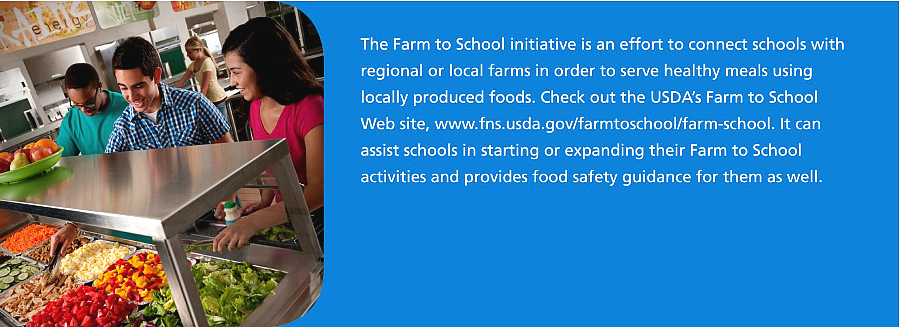
- Managing Food Allergies

A food allergy is an exaggerated immune response to a specific food, referred to as a food allergen. Although the immune system normally protects us from germs, in individuals with food allergies this system mistakenly responds to a food as if it is harmful. When exposed to a food allergen, the immune system of an allergic person makes a protein called IgE antibody. This protein alerts cells to release powerful chemicals, such as histamine, that cause symptoms that can affect the respiratory system, gastrointestinal tract, skin, or cardiovascular system, and can lead to a life-threatening reaction called anaphylaxis. Although more than 170 foods are known to cause a food allergy, in the United States, eight foods – milk, eggs, fish, crustacean shellfish, wheat, soy, peanuts, and tree nuts – account for 90 percent of these allergies.
Food allergies are a growing food safety and public health concern in schools that affect an estimated 4-6 percent of children in the United States. Studies indicate that 16-18 percent of children with food allergies have had a reaction from accidentally eating food allergens while at school. In addition, 25 percent of the severe and potentially life-threatening reactions (anaphylaxis) reported at schools happened in children with no previous diagnosis of food allergy. Currently, there are no treatments available for preventing food allergies; the key to managing food allergies is to avoid exposure to food allergens. However, avoidance is not always easy or possible, and accidental reactions to foods, including anaphylaxis, can occur in school.
It is important for your school district to develop and carry out policies and procedures to manage food allergies which may include educating staff, parents, and teachers about food allergies; preventing exposure to food allergens; and responding quickly and effectively to a child experiencing a reaction.
Food-Safe Schools Action Steps and Resources
- Educate yourself and your staff about food allergies.
- Food Allergies for School Nutrition Mangers and Staff is a training resources offered through the ICN.
- The ICN developed a variety food allergy resources for child nutrition professionals including food allergen fact sheets, videos, and a comprehensive training curriculum.
- Collaborate with other school community members to develop and implement a written food allergy management plan for each school in your district. A variety of resources are available to help you craft a plan, including:
- The Food Allergy Book: What School Employees Need to Know, developed by the USDA FNS and the National Education Association Health Information Network (NEA HIN), provides information in English and Spanish about food allergies and allergic reactions at school. It helps school employees identify the most common foods that might trigger an allergic reaction; the signs and symptoms of a severe, life-threatening allergic reaction, anaphylaxis; and their role in helping to manage food allergies in schools.
- The CDC Voluntary Guidelines for Managing Food Allergies in Schools and Early Care and Education Programs provide a framework to build strong partnerships among families, medical providers, and staff in schools to help children overcome the challenges that come from having a food allergy. The guidelines also call for strong leadership in schools, comprehensive plans for protecting students with food allergies, and effective responses to food allergy emergencies.
- As part of your action plan, give employees specific guidance on how to respond to a child’s allergic reaction and provide immediate emergency care. Food Allergy Research & Education (FARE) offers an emergency care plan template that can be used as a starting point.
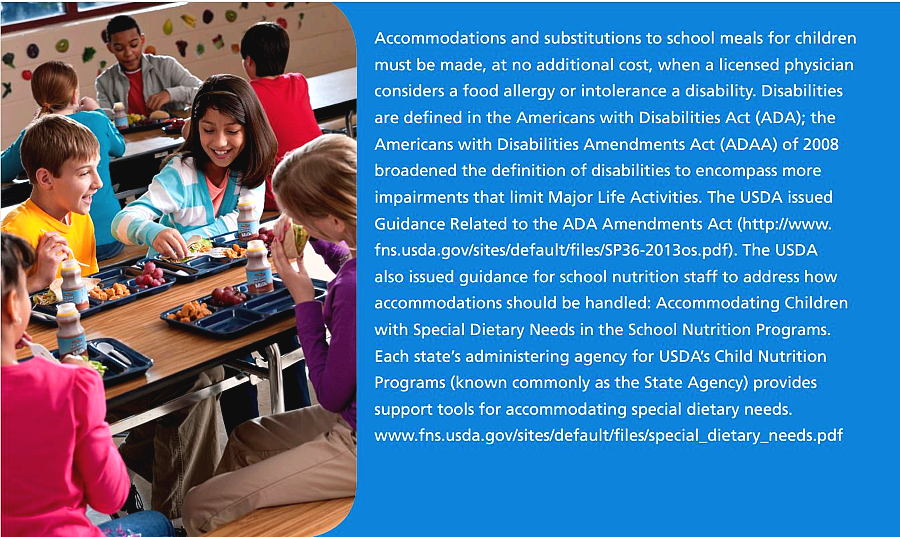
- Educate yourself and your staff about food allergies.
- Food Defense

Food defense means protecting food from intentional contamination by biological, chemical, physical, or radiological agents that can cause harm or death. Schools may be a target for an attack on their food supply for specific reasons: children are a vulnerable population; harming children who are assumed to be safe at school would have a major emotional impact on the community and beyond; schools provide very large numbers of servings per day; schools dispense very large batches of a single food on any given day; and activities such as transporting prepared foods from a central kitchen to a school site increase the risk of intentional contamination.
Also, food can be at risk of intentional contamination during handling at a school – from receiving through storing, preparing, and serving. Intentional acts are hard to predict and require an immediate and thorough response.
Food defense involves having measures in place to reduce the chances of someone intentionally contaminating the food in your school nutrition operation and to prepare for a quick response if an emergency does occur.
Food-Safe Schools Action Steps and Resources
- Develop and implement a written food defense plan for each school within your district.
- The USDA FNS offers a practical workbook tool, Creating Your School Food Defense Plan, that walks you through the process of developing a food defense plan.
- Train all school nutrition staff in your district on food defense.
- The FDA created a number of resources to raise awareness about food defense in the foodservice industry and assist foodservice managers in their food defense training and exercise programs. These resources can be accessed online and include:
- Test your district’s readiness to respond to a food defense incident by holding drills or exercises.
- Develop and implement a written food defense plan for each school within your district.
- Responding to Food Recalls

A food recall occurs when there is reason to believe that a food may cause illness or injury. A food manufacturer or distributor initiates the recall to take foods off the market. In some situations, government agencies request a recall based on information they receive following a complaint or an investigation of illness.
Some reasons for recalling food include:
- Discovery of a pathogen in a product, which may result in illness.
- Discovery of a physical hazard in a food, such as plastic, metal, or glass.
- Mislabeling or misbranding food. For example, a food may contain an allergen, such as nuts or eggs, but those ingredients do not appear on the label.
When a recall occurs, school nutrition operations must respond rapidly to make sure the recalled food is not served and to identify recalled food that may have been served already. Having procedures in place to respond to a food recall will assure a quick response and will protect children.
Food-Safe Schools Action Steps and Resources
- Contact your state agency, processors, suppliers, and distributors to learn how your school district will be alerted to food recalls. Recall procedures may differ for USDA Foods and commercial foods. USDA Foods are foods purchased by the USDA for child nutrition programs. Commercial foods are foods purchased directly from a commercial source such as a processor, supplier, distributor, or other vendor.
- Develop and implement a recall alert system within your school district to ensure that each school learns about food recalls rapidly and understands how to respond to a food recall alert.
- Responding to a Food Recall is a manual offered through the USDA FNS and ICN that provides an overview of the recall process for USDA Foods with a focus on school meals programs. Particular attention is given to the roles of various entities in communicating information to ensure that recalls are handled in a timely and effective manner.
- USDA Foods Recall Preparedness & Response Checklist
- Establish an inventory management system that tracks what food is in inventory, when it was received, where it is stored, and when and where it was distributed.
- The Inventory Management and Tracking Reference Guide, developed by the USDA FNS and ICN, presents information that may be new to school nutrition operators and updates information about traditional inventory management in light of new traceability expectations. This resource includes language for bids and processing agreements that requires suppliers and distributors to address recalls and product traceability.
- Responding to a Foodborne Illness Outbreak

A foodborne illness outbreak occurs when two or more people get the same illness from eating contaminated food from a common source. While foodborne illness outbreaks are relatively uncommon in schools, they do occur. Even one case of foodborne illness can be devastating. Outbreaks can threaten children’s lives. Parents can panic. Districts can be held financially liable.
Protecting the safety and welfare of students and school staff are priorities when a foodborne illness outbreak occurs at a school. An investigation of an outbreak goes through many steps. Each outbreak will have unique characteristics that present a variety of issues for investigators; therefore, it is important to be prepared to respond to different types of investigations. Due to the challenges associated with an investigation, it may take investigators days, weeks, or months to identify the source of contamination that caused illness. You can help decrease this investigation time, and possibly prevent new illnesses from occurring, by preparing your school nutrition team for an outbreak investigation, and helping them understand response expectations.
Food-Safe Schools Action Steps and Resources
- Work with your state or local health department to determine what records, documents, and information the school nutrition team will need to provide during an outbreak investigation.
- Develop procedures for employees to maintain complete records, documents, and information— and be able to retrieve them quickly.
- Food Safety in Schools (formerly Serving it Safe), offered through the ICN, provides school nutrition personnel at all levels with information for managing a safe and sanitary school foodservice operation. Food Safety in Schools includes guidance on preventing and responding to foodborne illness.
As you advance, work with your local health department to be sure your food safety efforts meet state and local food safety requirements as well. You may want to get input from your school administrators, teachers, and others in the school community who have experience or expertise to share. See Part 3 for tips on communicating with various members of the school community.


